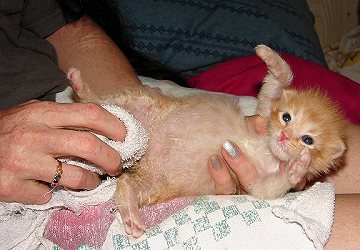| How to help the Kitty to eliminate | ||
The mother cat will stimulate her kitten's elimination by licking his anus and genital area with her rough tongue. You can emulate this process with a warm, rough washcloth. It may take a couple of feedings to see results, so don't despair if he doesn't defecate right away. Urinating may take a bit longer.
Normally, kittens will have a couple of firm, yellowish stools per day if they are being properly fed. Most kittens can control their own bowel movements at about 10 days old. The skin area is very delicate and may become raw or sore from your efforts. If this happens, apply a tiny dab of Preparation H ointment to the affected area after each stimulation. Keep in mind that your kitten will probably not have a bowel movement every feeding, and sometimes even skip a day. This should be fine as long as the kitten is growing, eating well, not showing any signs of distress, and urinating. Young kittens must be protected from disease!! ALWAYS wash your hands before and after handling the kittens, and ALWAYS clean and sterilize your bottles, nipples, brushes, or tube feeders in boiling water after each use!!
 Entirely Pets DIARRHEA/CONSTIPATION What does a loose and/or yellow stool mean? This would indicate a mild case of What does a loose and/or greenish color stool mean? This would be indicative that the food is moving too quickly through the kitten's system, and the bile is not being absorbed, and is probably attributed to moderate overfeeding. Cut the formula back with the Pedialyte or bottled water; in severe cases use 2 to 3 drops of Kaopectate every four hours until this problem clears up. What about stools that look like cottage cheese? Either the formula strength is too rich, there is severe overfeeding, or the kitten may have a bacterial infection. Check with the shelter manager who may recommend that you cut the formula in half with bottled water and/or Pedialyte liquid, and start the kitten on antibiotics. If the kitten is seriously dehydrated, fluids can be given under the skin. Constipated or straining kittens? In this case, you would want to increase the strength of the formula, and feed slightly smaller amounts, but feed more frequently. If the kitten has a swollen abdomen and hasn't passed a bowel movement in over a day, you may want to try mineral oil given by mouth (3 drops per ounce of body weight). Stool Color:
 Only Natural Pet Store Urine color:
| ||
10/12/05
How to help the Kitty to eliminate
Posted by
MissDolittle
at
09:26
![]()
Subscribe to:
Post Comments (Atom)


1 comment:
siamese cat for sale
siamese kittens for sale near me
siamese kittens
siamese cat
siamese cat
siamese cat
siamese cat for sale near me
siamese kittens for sale
Post a Comment